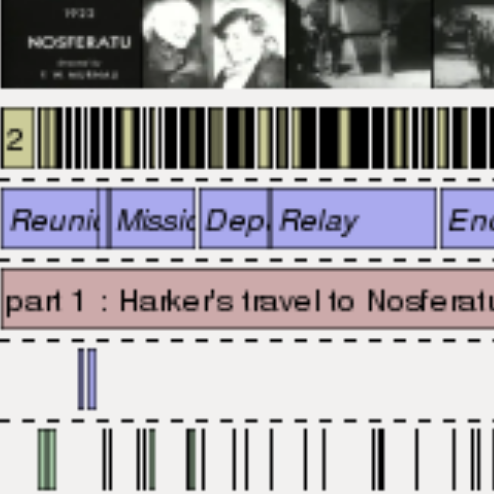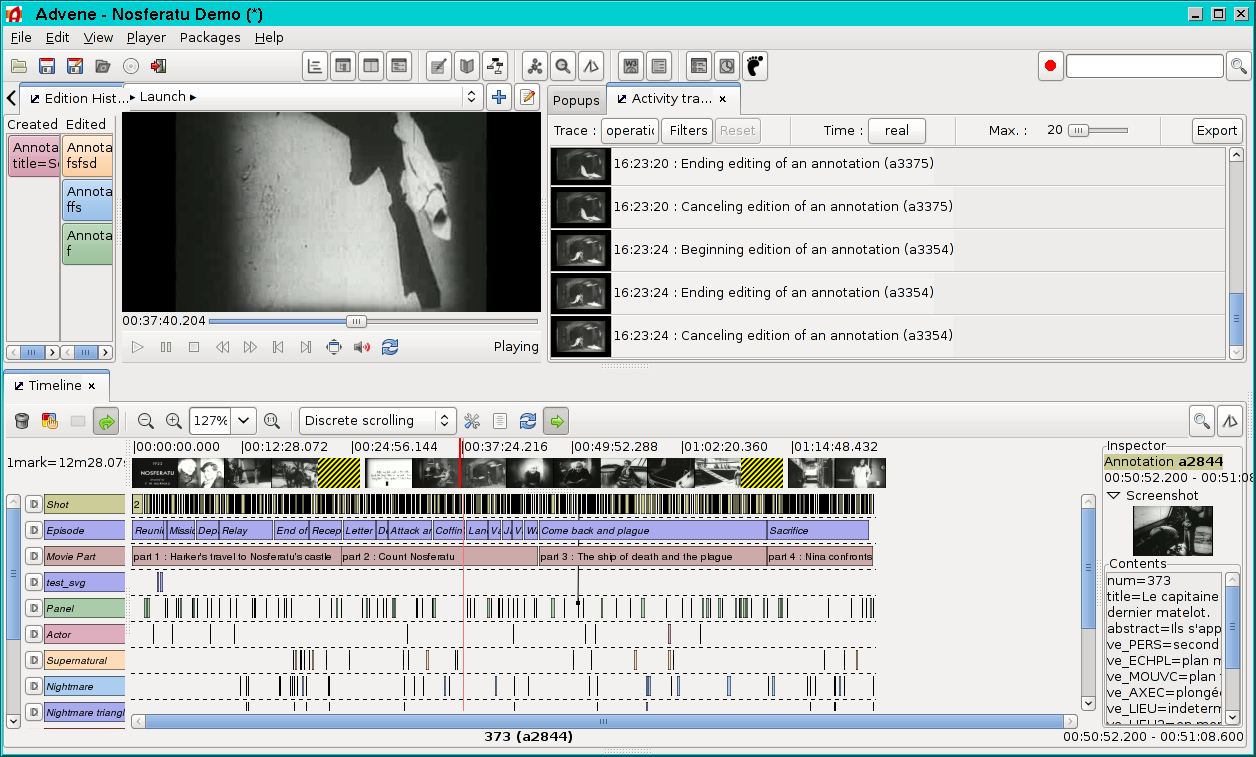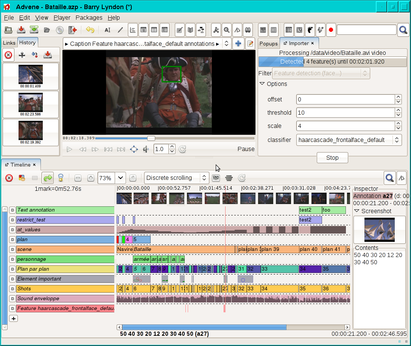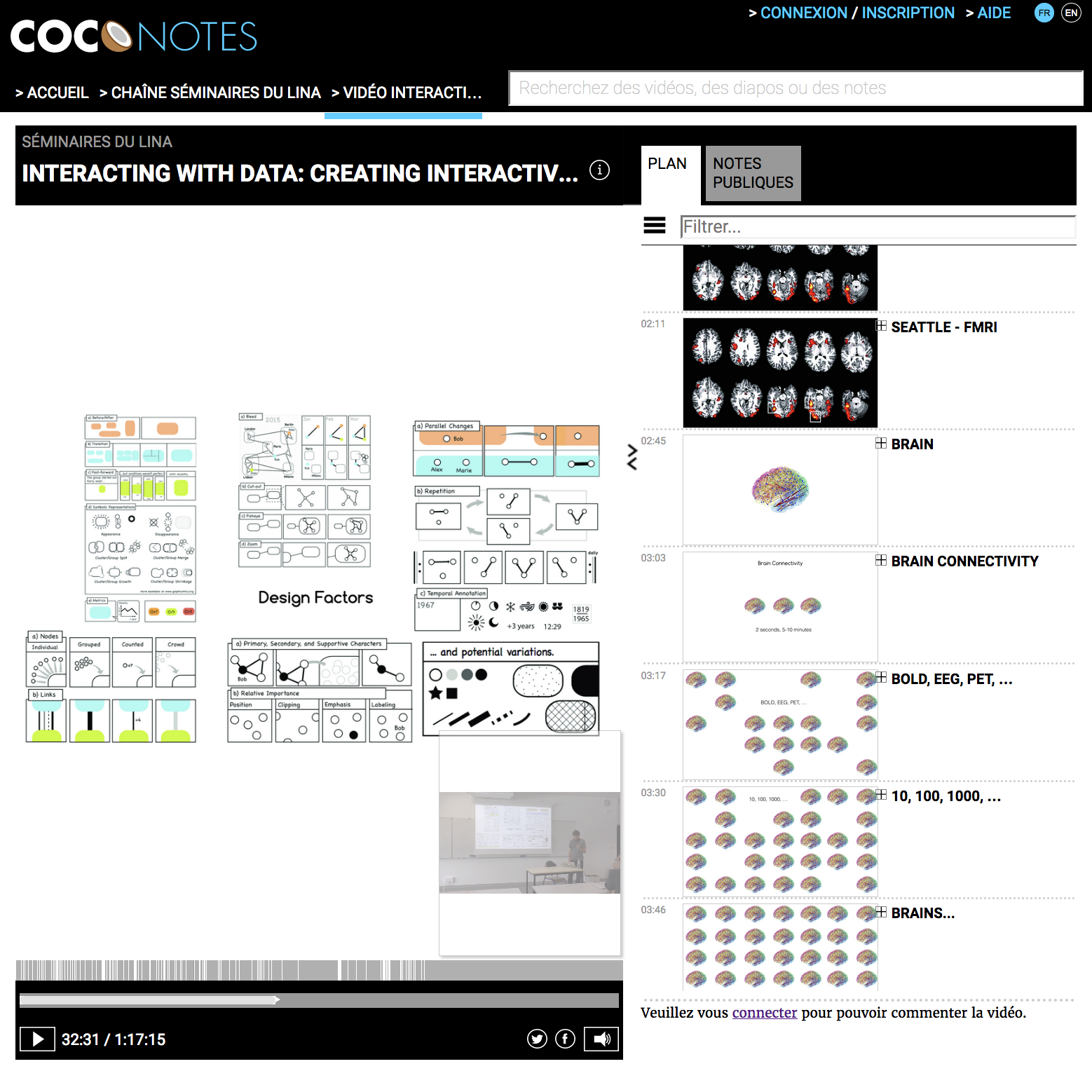Our work on Advene and Cinecast led to several conceptual and modelling proposals around hypervideo (web) rendering and user interaction with hypervideos.
-

ADVENE: Annotate Digital Video, Exchange on the NEt
Document Engineering
Hypervideos
Interpretation Systems
Reflective Systems
Video Annotations
Project on video annotations, hypervideos, concept, models and tools for video active reading. The Open-Source Advene software runs on Windows, Linux and Mac OS. It features the Cinelab / Advene2 model for Hypervideo description and Exchange. A lot of information can be found on the website.
Details
Partners: Numerous
Funding: at first no funding (2003-2007), then Cinelab project on film annotations (ANR RIAM, 2007-2008, with LIRIS, IRI Centre Pompidou, Forum des Images, Antenna Audio), then Bertrand Richard PhD thesis, and other projects (notably Cinecast on Film Digital Libraries).
Beginning: 2002-10-01
End: false
Website: http://advene.org
Related publications
-
Olivier Aubert, Yannick Prié, Daniel Schmitt. (2012) Advene as a Tailorable Hypervideo Authoring Tool: a Case Study in ACM Symposium on Document Engineering, Paris, sept 2012, pp. 79-82 . doi Show abstract Audiovisual documents provide a great primary material for analysis in multiple domains, such as sociology or interaction studies. Video annotation tools offer new ways of analysing these documents, beyond the conventional transcription. However, these tools are often dedicated to specific domains, putting constraints on the data model or interfaces that may not be convenient for alternative uses. Moreover, most tools serve as exploratory and analysis instruments only, not proposing export formats suitable for publication. We describe in this paper a usage of the Advene software, a versatile video annotation tool that can be tailored for various kinds of analyses: users can define their own analysis structure and visualizations, and share their analyses either as structured annotations with visualization templates, or published on the Web as hypervideo documents. We explain how users can customize the software through the definition of their own data structures and visualizations. We illustrate this adaptability through an actual usage for interview analysis.
-
Yannick Prié. (2009) Interacting with Annotated Videos in In Workshop Interacting with temporal data at CHI 2009. Boston, MA, April 2009. 4pp. Show abstract We present Advene, a project and a prototype dedicated to video active reading, i.e. inscribing annotations on a video document and taking advantage of these annotations for navigating it. Both the video and its annotations are temporal data that need to be presented and interacted with. We present some illustrative interfaces, and discuss some of the challenges related to such a complex activity.
-
Olivier Aubert, Pierre-Antoine Champin, Yannick Prié, Bertrand Richard. (2008) Canonical processes in active reading and hypervideo production in Multimedia Systems Journal, Special Issue on Canonical Processes of Media Production. 14(6):427-433, 2008 doi Show abstract Active reading of audiovisual documents is an iterative activity, dedicated to the analysis of the audiovisual source through its enrichment with structured metadata and the definition of appropriate visualisation means for this metadata, producing new multimedia objects called hypervideos. We will describe in this article the general decomposition of active reading and how it is put into practice in the Advene framework, analysing how its activities fit into the Canonical Media Processes model.
-
Bertrand Richard, Yannick Prié, Sylvie Calabretto. (2008) Towards a unified model for audiovisual active reading in Tenth IEEE International Symposium on Multimedia, Berkeley, CA, USA, dec 2008. [AR:24%] doi Show abstract Audiovisual active reading is a commonly practised activity in different fields. This creative process consists in describing, criticizing and building an analysis during the reading of a document. More and more tools aim at providing ways to perform part of this activity, built on diferent description models. However, the whole activity is lacking a full support. In this paper, we present our work on a unified model for active reading of audiovisual documents, taking into account each part of this activity. Our approach is based on active reading data and activity modeling so as to propose a pertinent, generic and adaptive model.
-
Olivier Aubert, Pierre-Antoine Champin, Yannick Prié. (2008) Advene, une plate-forme ouverte pour la construction d'hypervidéos in Ludovia 2008, Ax-les-Thermes, aug 2008, 10 pp. Show abstract Nous présentons le projet Advene et les enjeux abordés : 1/ la question du public visé et apte à s'emparer d'un nouvel outil pour construire de nouvelles pratiques ; 2/ la souplesse nécessaire pour permettre de développer des pratiques innovantes (qui pourra entrer en conflit avec la nécessaire convivialité d'un outil s'adressant à un large public) ; 3/ les enjeux soulevés par le projet qui dépassent largement des aspects techniques ou ergonomiques et posent également des questions sur le droit d'auteur.
-
Yannick Prié, Ilias Yocaris. (2007) Informatique et analyse filmique : indécidabilité et contagion sémiotique dans Epidemic de Lars von Trier in Semio 2007, 8pp. Show abstract D’un point de vue strictement technique, notre exposé vise à esquisser une méthode de travail permettant de créer de nouveaux outils stylistiques destinés à l’analyse filmique. Pour ce faire, nous nous proposons d’analyser le film de Lars Von Trier et Niels Vørsel Epidemic (1988 ; tourné en noir et blanc). Partant d’une étude détaillée du fonctionnement sémio-stylistique de ce film, nous entendons montrer : (1) Qu’il se présente comme un « système textuel » (cf. Metz 1971 : 107-108 et passim) découlant d’une série d’interactions extrêmement complexes entre différents codes sémiotiques (discursifs, picturaux, narratifs, génériques …) ; (2) Que sa dimension « pluri-codique » (Metz 1971 : 90) doit être décrite dans le cadre d’une approche résolument interdisciplinaire, permettant de conjoindre aux acquis de la sémiotique filmique une série de concepts empruntés à la stylistique textuelle (le concept riffaterrien de « convergence »), à la narratologie (le concept genettien de « métalepse narrative »), à la philosophie du langage (le concept goodmanien d’« exemplification », le concept derridien d’« indécidabilité ») etc. ; (3) Que l’efficacité d’une telle démarche d’analyse est démultipliée par l’utilisation d’outils informatiques adéquats, qui peuvent être développés ad hoc.
-
Pierre-Antoine Champin, Yannick Prié. (2007) Models for sustaining emergence of practices for hypervideo in International Workshop On Semantically Aware Document Processing And Indexing (SADPI'07), May 2007, 10pp. Show abstract The work presented in this paper aims at covering several domains: hypervideo modelling, document annotation, and practices sharing and emergence. It is based on the Advene project, providing a model and a prototype for creating, rendering and sharing annotations of audiovisual documents. After a presentation of the notion of multi-structurality in documents and a definition of hypervideos, we present the original Advene model. We then discuss some limitations observed in our model, and introduce a new model for hypervideos. We finally discuss related work with respect to our model, and raise the problem of the emergence of semantics in videos and hypervideos.
-
Olivier Aubert, Yannick Prié. (2007) Annotations de documents audiovisuels - Temporalisation et spatialisation in Atelier Interfaces pour l'annotation et la manipulation d'objets temporels : une comparaison des outils et des paradigmes dans le domaine musical et cinématographique, nov 2007, Paris. Show abstract Le prototype open-source Advene offre une plateforme pour l’intégration, la visualisation et l’échange de métadonnées sur des documents audiovisuels. Il permet aux utilisateurs de définir eux-mêmes, en fonction des tâches à effectuer, les structures des métadonnées et la manière de les visualiser. Il permet ainsi de mettre en ½uvre des pratiques de lecture active de documents audiovisuels. Nous présentons ici quelques éléments de réflexion sur la pratique d’annotation de documents temporalisés.
-
Bertrand Richard, Yannick Prié, Sylvie Calabretto. (2007) Lecture active de documents audiovisuels : organisation de connaissances personnelles par la structuration d’annotations in Ingénierie des Connaissances 2007, Grenoble, July 2007, 12 pp. Show abstract Au cours de la pratique de la lecture active, un lecteur manipule une quantité importante de connaissances, liées à sa pratique et au document étudié. Ces connaissances au coeur de l’activité sont amenées à évoluer afin de correspondre au mieux à la pratique du lecteur. Nous présentons dans cet article nos réflexions relatives à la construction et la manipulation de connaissances personnelles au cours de cette activité et à l’évolution de ces connaissances au fil de la pratique. Après étude des modèles existants, nous proposons un modèle de structuration de connaissances adapté aux contraintes de la lecture active et permettant de diffuser les différentes pratiques de la lecture active.
-
Olivier Aubert, Yannick Prié. (2007) Advene: an open-source framework for integrating and visualising audiovisual metadata in Open Source Competition: Technical presentation and overview paper, Proc. of ACM Multimedia Conference, Augsburg, sept. 2007, pp. 1005-1008. doi Show abstract The open-source Advene prototype offers a framework for integrating and visualising audiovisual metadata. It allows users to define by themselves, according to their specific tasks, the structure of the metadata as well as the different ways in which it should be visualised. By storing metadata and visualisation specifications independently from the audiovisual document, it allows to share analyses and comments on any audiovisual document. Its open nature and simple principles make it an ideal testbed for experimentation with new audiovisual metadata interaction modalities.
-
Olivier Aubert, Yannick Prié. (2006) Des vidéos aux hypervidéos : vers d'autres interactions avec les médias audiovisuels in Technique et science informatique, Vol 25, num 4, 2006, pp. 409-436, 2006. doi Show abstract La numérisation des documents permet d'en envisager des exploitations novatrices, comme la démontré le succès du web. La capacité des systèmes informatiques permet maintenant d'exploiter les documents audiovisuels, mais tous les concepts et outils ne sont pas encore présents. Afin de fournir un support à la réflexion sur les utilisations innovantes des documents audiovisuels numériques, nous présentons et discutons ici la notion d'hypervidéo, qui permet d'une part, d'analyser des instances existantes d'hypervidéos, et d'autre part, de donner un guide de construction pour des systèmes mettant en oeuvre les hypervidéos. Nous décrivons ensuite le projet Advene, qui vise à fournir une plate-forme permettant 1) la création d'hypervidéos (visualisations dynamiques et statiques de données associées à un médium audiovisuel) ; 2) l'échange des données et des vues associées, afin de permettre un travail collaboratif sur ce type de médium.
-
Olivier Aubert, Pierre-Antoine Champin and Yannick Prié. (2006) Integration of Semantic Web Technology in an Annotation-based Hypervideo System in SWAMM 2006, 1st International Workshop on Semantic Web Annotations for Multimedia, Held as part of the 15th World Wide Web Conference, May 2006, 12 pp. Show abstract This article discusses the integration of semantic web technologies (ontology and inference) into audiovisual annotation based models and systems. The Advene project, aimed at all purpose hypervideo generation from annotated audiovisual documents, is used as a testbed. Advene principles and the Advene prototype are first presented, before a discussion on how ontology and reasoning have been easily integrated into the Advene framework. Some motivating examples are proposed, and our proposals and related works are discussed.
-
Olivier Aubert, Yannick Prié. (2005) Des hypervidéos pour créer et échanger des analyses de documents audiovisuels in H2PTM 2005, Créer, jouer, échanger : expériences de réseaux, nov. 2005, Paris, 10 pp. Show abstract Les possibilités offertes par l'hypertexte ne sont pas encore très exploitées dès lors que l'on travaille avec des documents audiovisuels. Le besoin de métadonnées y est plus immédia- tement perceptible, la temporalité des documents pose des problèmes nouveaux en termes de manipulation et d'interaction, et la question des droits étant loin d'être réglée. Afin de pouvoir analyser les expérimentations novatrices actuelles dans ce domaine et éclairer la construction de nouveaux systèmes, nous présentons la notion d'hypervidéo comme cadre général mettant en évidence différentes dimensions des hypermédias à base de documents audiovisuels. Le projet open-source Advene nous permet de mener des expérimentations de mise en application des hypervidéos et fournit un support à l'innovation par le bas propice à l'émergence de nouveaux modes d'interaction audiovisuelle.
-
Olivier Aubert and Yannick Prié. (2005) Advene: Active Reading through Hypervideos in ACM Conference on Hypertext and Hypermedia 05, 2005, Salzburg, Austria, pp. 235-244. [AR:36%] doi Show abstract Active reading and hypermedia usage are an integral part of scholar daily practices, but the full exploitation of their potentialities still lies far ahead. In the search for new methods and tools, we focus in this article on the use of audiovisual material in a scholar context. One of the results of active reading applied to audiovisual material can be hypervideos, that we define as views on audiovisual documents associated with an annotation structure. The notion of hypervideo is useful to analyse existing video-based hypermedia systems as well as building new systems. The Advene project proposes an implementation of hypervideos through a framework that allows experimentations of new visualisation and interaction modalities for enriched videos.
-
Olivier Aubert, Yannick Prié. (2004) Documents audiovisuels instrumentés. Temporalités et détemporalisations dans les hypervidéos in Document numérique, numéro spécial : Temps et document, vol. 8, num. 4, pp.143-168, 2004. doi Show abstract Nous nous intéressons tout d’abord dans cet article aux documents audiovisuels et aux diverses temporalités qui leur sont liées. Après un état des lieux des possibilités actuelles des systèmes d’information audiovisuelle, nous définissons plus précisément ce que sont les hyper- vidéos, ou documents audiovisuels numériques instrumentés. Nous décrivons et illustrons alors un certain nombre des caractéristiques des objets hypervidéos en lien avec les temporalités dé- finies, qui en font des objets complexes. Nous présentons alors un début de cadre d’analyse des synchronisations entre temporalités des hypervidéos générées et vécues.
-
Olivier Aubert, Yannick Prié. (2004) From video information retrieval to hypervideo management in International Workshop on Multidisciplinary Image, Video, and Audio Retrieval and Mining. Sherbrooke-Canada, October 25-26 2004 Show abstract The digital revolution that has somehow taken place with the World-Wide Web took advantage of the availability and interoperability of tools for visualisation and manipulation of text-based data, as well as the satisfying pertinence of search engines results that makes them usable by non-expert users. If we are to undergo such a revolution in the audiovisual domain, a number of issues mainly related to the temporal nature of audiovisual documents have to be resolved. In this article, we expose our view of the current state of Audiovisual Information Systems, and suggest that they should be considered as video information management systems rather than video retrieval systems, in order to foster new uses of video information. We define the notion of hypervideo that can be used as an analysis framework for this issue. We then describe our implementation of hypervideos in the Advene framework, which is aimed at DVD material annotation and analysis. We eventually discuss how the notion of hypervideo puts video information retrieval in a somewhat different light.
-
Olivier Aubert, Pierre-Antoine Champin, Yannick Prié. (2003) Instrumentation de documents audiovisuels : temporalisations et détemporalisation dans le projet Advene in Workshop "Temps et documents numériques", Nov 2003, Grenoble, France. 2003 Show abstract Nous présentons dans cet article les différents éléments du modèle Advene pour représenter des annotations audiovisuelles, et présenter celles-ci à l’utilisateur sous la forme l’hypervidéos, documents hypermédias générés à partir du document audiovisuel original annoté et des annotations. Les hypervidéos sont des documents multimédias complexes, du fait de la part importante prise par l’élément vidéo, qui possède des temporalités particulières. Afin d’être à même de construire des hypervidéos conduisant à des utilisations novatrices du matériel audiovisuel, nous proposons un modèle d’analyse de celles-ci suivant différentes temporalités.
Related software
Additional comments
Please use ACM Hypertext 2005 reference as main citation.
Additional illustrations


-

COCo: Comin Open Courseware
Technology-Enhanced Learning
Hypervideos
Video Annotations
Research and development aimed at leveraging annotations in video-centered pedagogical resources, creating open courseware multimodal content for knowledge diffusion, and exploring new techniques for e-learning. More than 30 courses and seminar videos have been produced.
Details
Partners: LS2N
Funding: Labex Cominlabs
Cofunding: Région Pays de la Loire
Beginning: 2013-09-01
End: 2016-12-31
Website: http://www.comin-ocw.org/
Related publications
-
Camila Canellas, Olivier Aubert, Yannick Prié. (2015) Prise de note collaborative en vue d’une tâche : une étude exploratoire avec COCoNotes Live in 17ème Conférence sur les Environnements Informatiques pour l'Apprentissage Humain (EIAH 2015), Jun 2015, Agadir, Maroc. pp.204-209, 2015 Show abstract Les enregistrements de présentations orales telles que celles effectuées lors de conférences peuvent souvent constituer une base pour 1) une nouvelle activité basée sur leur contenu, 2) une autre forme pour le même contenu, ou 3) une combinaison avec d'autres documents. Cependant, les enregistrements vidéo peuvent se révéler difficiles à naviguer et explorer. Nous présentons ici les résultats préliminaires d’une situation où un outil de microblogging est utilisé durant l'enregistrement pour produire des annotations catégorisées et synchronisées avec l'enregistrement. Les annotations sont ensuite utilisées pour naviguer dans l'enregistrement et produire de nouveaux documents, dans le contexte d'une tâche spécifique.
-
Olivier Aubert, Yannick Prié, Camila Canellas. (2014) Leveraging video annotations in video-based e-learning in 6th International Conference on Computer Supported Education, Barcelona, Spain, April 2014 Show abstract The e-learning community has been producing and using video content for a long time, and in the last years, the advent of MOOCs greatly relied on video recordings of teacher courses. Video annotations are information pieces that can be anchored in the temporality of the video so as to sustain various processes ranging from active reading to rich media editing. In this position paper we study how video annotations can be used in an e-learning context - especially MOOCs - from the triple point of view of pedagogical processes, current technical platforms functionalities, and current challenges. Our analysis is that there is still plenty of room for leveraging video annotations in MOOCs beyond simple active reading, namely live annotation, performance annotation and annotation for assignment; and that new developments are needed to accompany this evolution.
Related software
Additional comments
The project was focused on open education and open course ware (OCW), all material is available on the project website.
Select another theme:
Accessibility
Affordances
Data Visualization
Digital Instruments
Document Engineering
Experience analysis and modelling
Hypervideos
Immersive Analytics
Interpretation Systems
Knowledge Engineering
Learning Analytics
Patient Experience
Progressive analytics
Reflective Systems
Technology-Enhanced Learning
Trace-based Activity Analysis
Trace-based Systems
VR and Psychotherapy
Video Annotations
Virtual Reality




